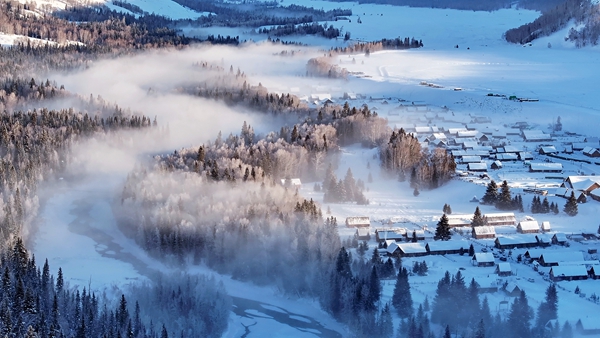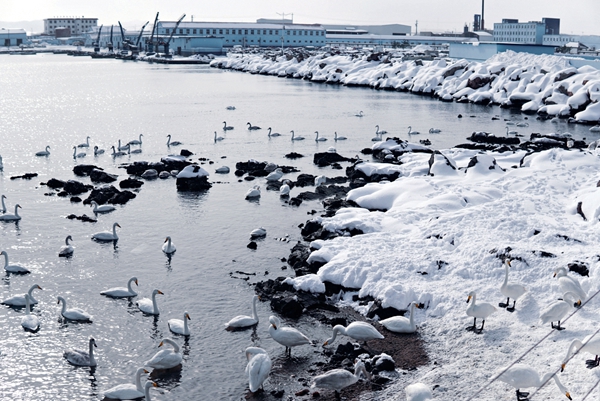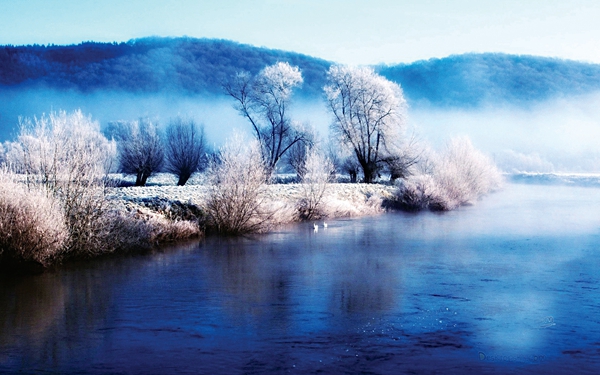Discovery | Enjoying Breathtaking Winter Landscapes

Nestled in Northeast China's Heilongjiang Province, Harbin, a city famous for its ice sculptures and snow-covered views, has emerged as a rising star in the country's burgeoning winter tourism industry, especially since the end of 2023. The unprecedented influx of tourists, captivated by the enchanting icy landscapes and the locals' warm hospitality, has propelled the "ice city," despite its frosty climate, to the forefront as one of the most talked-about and sought-after travel destinations in China. Topics involving winter tourism in China have circulated across the Internet. Sound infrastructure and thoughtful services have made Harbin successful as a tourist destination. To attract more tourists, Harbin has rolled out an ar ray of activities, including performances, firework displays, theme parks, and intangible-heritage-culture shows. Also, travelers have had good experiences in the city, due to locals' kindness and generosity. As a "front runner," Harbin's success has epitomized the vigorous growth of China's winter tourism industry. In this issue, Women of China English Monthly recommends several enchanting winter tourism destinations, each of which is renowned for its breathtaking winter landscape.

White Fairyland
Hidden deep in the Altay Mountains, Hemu Village is situated in Burqin, a county in Northwest China's Xinjiang Uygur Autonomous Region. Dubbed China's "most beautiful village," Hemu features fascinating landscapes and wooden houses made with stacked logs. Winter in Hemu can last as long as seven months. The snow-covered wooden houses, against the blue sky with white clouds and snow-covered mountains and forests, resembles a mesmerizing ink painting. Hemu, like a fairyland, is an ideal place to escape the hustle and bustle of modern life. Kanas Lake is a famous sightseeing spot near the village.

Morning is the best time to enjoy the lake's picturesque scenery. Early in the winter mornings, the lake is surrounded by magical-looking mist. The trees seem to be wearing silver clothing (the frost). As the sun rises, the snow-capped mountains become "dyed" in gold. The breathtaking scenery makes the lake a paradise for photographers.

Magnificent Mountainous Scenery
Siguniang Mountain, or Four Girls Mountain, is situated in Xiaojin, a county in Aba Tibetan and Qiang Autonomous Prefecture, in Southwest China's Sichuan Province. The mountain range features four snow-capped peaks — Dafeng (Eldest Sister Peak), Erfeng (Second Sister Peak), Sanfeng (Third Sister Peak), and Yaomeifeng (Youngest Sister Peak) –– and three picturesque valleys, Shuangqiao Valley, Changping Valley and Haizi Valley. Dubbed the "Oriental Alps," Siguniang Mountain is well-known for its magnificent peaks, alpine meadows and primeval forests. In winter, the snow-covered peaks, meadows and trees create a fairy tale world. Shuangqiao Valley is one of the most popular ice-climbing destinations in China. The large scale and high concentration of ice falls, on both sides of the canyon, have attracted countless tourists.

Snowy 'Swan Lake'
The national nature reserve for whooper swans is located in Rongcheng, a county-level region in Weihai, a city in East China's Shandong Province. Given its unique geographical location, and the comprehensive ecological protection of the wetlands, Rongcheng provides favorable natural conditions and an abundant supply of food for whooper swans to spend the winter. Dubbed "Swan Lake," it is one of the largest wintering habitats for whooper swans in the world. Every November, tens of thousands of whooper swans migrate to Rongcheng from Siberia, Russia, and North China's Inner Mongolia Autonomous Region. The swans return north between March and April. Yandunjiao, a coastal village in Rongcheng, is an ideal place for visitors to appreciate the whooper swans. When walking along the shore, flocks of swans can be seen gathering in shallow water, sometimes foraging for food, and sometimes preening or flapping their wings. The magnificent scenes, composed of countless swans and the snow-covered coast, attract countless tourists and photographers, from home and abroad, every winter.

Mesmerizing Natural Wonders
Rime, popularly known as tree hanging or frost flowers, is formed on tree branches by the rapid freezing of water vapor in the air. Along with the natural landscapes in Guilin (a city in Guangxi Zhuang Autonomous Region), stone forests in Yunnan Province, and the Three Gorges (on the Yangtze River), the "rime scenery" is widely considered to be one of the four natural wonders in China.

Rime Island, located in Wulajie, a small Manchu town in Jilin, a city in Northeast China's Jilin Province, is a small island on the Songhua River. It is one of the well-known scenic spots that boast the beautiful rime scenery in winter. The best time to enjoy the mesmerizing scenery is between late December and late February. During that time, the weeping willows on the island are dressed in pure white, creating a winter wonderland straight out of a fairy tale.
Photos from Shen Haibin, Tuchong and VCG
(Women of China English Monthly February 2024)
Please understand that womenofchina.cn,a non-profit, information-communication website, cannot reach every writer before using articles and images. For copyright issues, please contact us by emailing: website@womenofchina.cn. The articles published and opinions expressed on this website represent the opinions of writers and are not necessarily shared by womenofchina.cn.








.jpg)

 WeChat
WeChat Weibo
Weibo 京公网安备 11010102004314号
京公网安备 11010102004314号